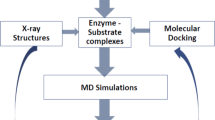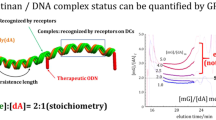Abstract
MOLECULAR rotation of any glycoside containing an optically active aglycone is equal, according to Klyne1, to the sum of the molecular rotations of the corresponding methylglycoside and aglycone. This rule has been used successfully many times for the calculation of molecular rotations of the glycosides containing steroid substances as aglycones2, later for the calculation of molecular rotations of glycoalkaloids3. Hitherto, this rule has not been used for calculations of molecular rotations of disaccharides, which can also be considered as glycosides. Some complications are to be expected, as a disaccharide, containing two hexosepyranoid units, can exist in at least eleven isomers which differ in their values of specific and molecular rotations. The contribution of the aglyconic part of the molecule will influence the molecular rotation of the whole molecule in an unknown fashion.
This is a preview of subscription content, access via your institution
Access options
Subscribe to this journal
Receive 51 print issues and online access
$199.00 per year
only $3.90 per issue
Buy this article
- Purchase on Springer Link
- Instant access to full article PDF
Prices may be subject to local taxes which are calculated during checkout
Similar content being viewed by others
References
Klyne, J., Biochem. J., 47, xli (1950).
Reichstein, T., Helv. Chim. Acta; almost all papers of the series “Glycosides and Aglycones” (1950–55).
Staněk, J., Chem. and Indust., 488 (1956).
Hudson, C. S., J. Amer. Chem. Soc., 38, 1566 (1916).
Schukoff, I., Z. deut. Zuckerindust., 2, 818 (1900); 2, 948 (1900).
Hudson, C. S., and Johnson, J. M., J. Amer. Chem. Soc., 37, 2748 (1915).
Vogel, H. V., and Debowska-Kurnicka, H. D., Helv. Chim. Acta, 11, 910 (1928).
Sharp, Violet E., and Stacey, M., J. Chem. Soc., 285 (1951).
Haworth, W. N., and Hickinbottom, W. J., J. Chem. Soc., 2847 (1931).
Micheel, F., and Hagel, K. O., Ber., 85, 1087 (1952).
Schlubach, H. H., and Schetelig, W., Z. physiol. Chem., 213, 83 (1932).
McClosky, C. M., Pyle, R. E., and Coleman, G. H., J. Amer. Chem. Soc., 66, 349 (1940).
Fischer, E., and Delbrück, K., Ber., 42, 2776 (1908).
Thompson, A., Anno, K., Wolfrom, M. L., and Inatome, M., J. Amer. Chem. Soc., 76, 1309 (1954).
Author information
Authors and Affiliations
Rights and permissions
About this article
Cite this article
STANĚK, J. Optical Rotation of the Isomeric Trehaloses. Nature 179, 97–98 (1957). https://doi.org/10.1038/179097a0
Issue Date:
DOI: https://doi.org/10.1038/179097a0
Comments
By submitting a comment you agree to abide by our Terms and Community Guidelines. If you find something abusive or that does not comply with our terms or guidelines please flag it as inappropriate.



